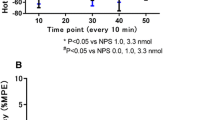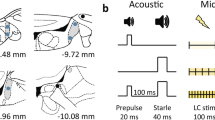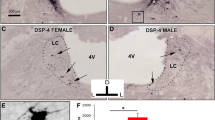Abstract
The relationship between norepinephrine (NE) content in cortex and spinal cord and acoustic startle amplitude was investigated in two experiments. Administration of diethyldithiocarbamate (DDC) depressed startle amplitude at the same time and dose that it most severely depleted NE content. These results support the conclusion that NE facilitates the normal elaboration of the acoustic startle reflex and also support evidence that NE activity in the spinal cord may be of particular importance in the maintenance of normal startle amplitude.
Similar content being viewed by others
References
Andén NE, Grabowska M, Strömbom U (1976) Different α-adrenoceptors in the central nervous system mediating biochemical and functional effects of clonidine and receptor blocking agents. Naunyn-Schmiedeberg's Arch Pharmacol 292:43–52
Astrachan DI, Davis M (1981) Spinal modulation of the acoustic startle response: The role of norepinephrine, serotonin and dopamine. Brain Res 206:223–228
Cooper JR, Bloom FE, Roth RH (1982) The biochemical basis of neuropharmacology. Oxford University Press, New York
Davidson M, Feinleib M (1972) Carbon disulfide poisoning: A review. Am Heart J 83:100–114
Davis M (1980) Neurochemical modulation of sensory-motor reactivity: Acoustic and tactile startle reflexes. Neurosci Biobehav Rev 4:241–263
Davis M, Aghajanian GK (1976) Effects of apomorphine and haloperidol in the acoustic startle response in rats. Psychopharmacology 47:217–233
Davis M, Astrachan DI (1981) Spinal modulation of acoustic startle: Opposite effects of clonidine and d-amphetamine. Psychopharmacology 75:219–225
Davis M, Cedarbaum JM, Aghajanian GK, Gendelman DS (1977) Effects of clonidine on habituation and sensitization of acoustic startle in normal decerebrate and locus coeruleus-lesioned rats. Psychopharmacology 51:243–253
Davis M, Svensson TH, Aghajanian GK (1975) Effects of d- and l-amphetamine on habituation and sensitization of the acoustic startle response in rats. Psychopharmacologia 43:1–11
Eneanya DI, Bianchine JR, Duran DO, Andresen BD (1981) The actions and metabolic fate of disulfiram. Annu Rev Pharmacol Toxicol (Copenh) 21:575–596
Farnebo LO, Hamberger B (1971) Drug-induced changes in the release of 3H-noradrenaline from field-stimulated rat iris. Br J Pharmacol 43:97–106
Fechter LD (1974) The effect of l-dopa, clonidine and apomorphine on acoustic startle reaction in rats. Psychopharmacologia 39:331–344
Goldstein M, Anagoste B, Lauber E, McKereghan MR (1964) Inhibition of dopamine-β-hydroxylase by disulfiram. Life Sci 3:763–767
Hefti F, Melamed E, Wurtman RJ (1980) Partial lesions of the dopaminergic nigrostriatal system in rat brain: Biochemical characterization. Brain Res 195:123–137
Kehne JH, Sorenson CA (1978) The effects of pimozide and phenoxybenzamine pretreatments on amphetamine and apomorphine potentiation of the acoustic startle response in rats. Psychopharmacology 58:137–142
Kokkinidis L, Anisman H (1978) Involvement of norepinephrine in startle arousal after acute and chronic d-amphetamine administration. Psychopharmacology 59:285–292
Krantz KD, Seiden LS (1968) Effects of diethyldithiocarbamate on the conditioned avoidance response of the rat. J Pharm Pharmacol 20:166–167
Lindvall O, Bjorklund A (1974) The organization of the ascending catecholamine neuron systems in the rat brain. Acta Physiol Scand (Suppl) 412:1–48
Magos L (1972) Toxicity of carbon disulfide. Ann Occup Hyg 15:303–309
Magos L, Jarvis J (1970) The effects of diethyldithiocarbamate and CS2 on brain tyrosine. J Pharm Pharmacol 22:936–938
McKenna MJ, DiStefano V (1977) Carbon disulfide. II. A proposed mechanism for the action of carbon disulfide on dopamine-β-hydroxylase. J Pharmacol Exp Ther 202:253–266
Moore KE (1969) Effects of disulfiram and diethyldithiocarbamate on spontaneous locomotor activity and brain catecholamine levels in mice. Biochem Pharmacol 18:1627–1634
Nygren L, Olson L (1977) A new major projection from locus coeruleus: The main source of noradrenergic nerve terminals in the ventral and dorsal columns of the spinal cord. Brain Res 132:85–93
Rainey JM (1977) Disulfiram toxicity and carbon disulfide poisoning. Am J Psychiatry 134:371–378
Svensson TH (1973) Increased dopamine concentration in the striatum in the mouse by FLA-63, a dopamine-β-hydroxylase inhibitor. J Pharm Pharmacol 25:73–75
Svensson TH, Bunney BS, Aghajanian GK (1975) Inhibition of both noradrenergic and serotonergic neurons in brain by the α-adrenergic agonist clonidine. Brain Res 92:291–306
Author information
Authors and Affiliations
Rights and permissions
About this article
Cite this article
Storm, J.E., Millington, W.R. & Fechter, L.D. Diethyldithiocarbamate depresses the acoustic startle response in rats. Psychopharmacology 82, 68–72 (1983). https://doi.org/10.1007/BF00426383
Received:
Accepted:
Issue Date:
DOI: https://doi.org/10.1007/BF00426383




